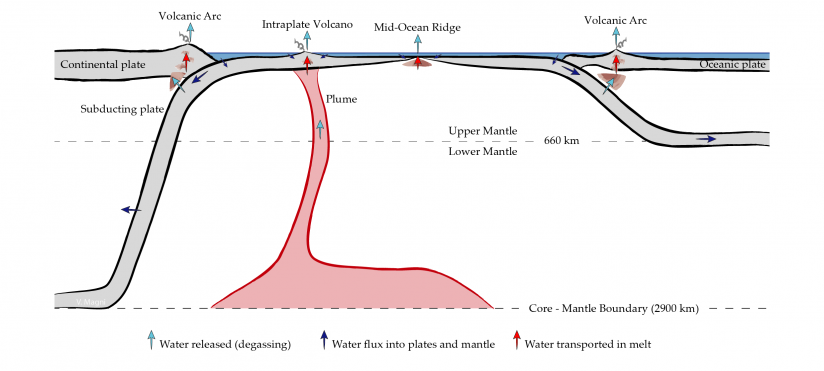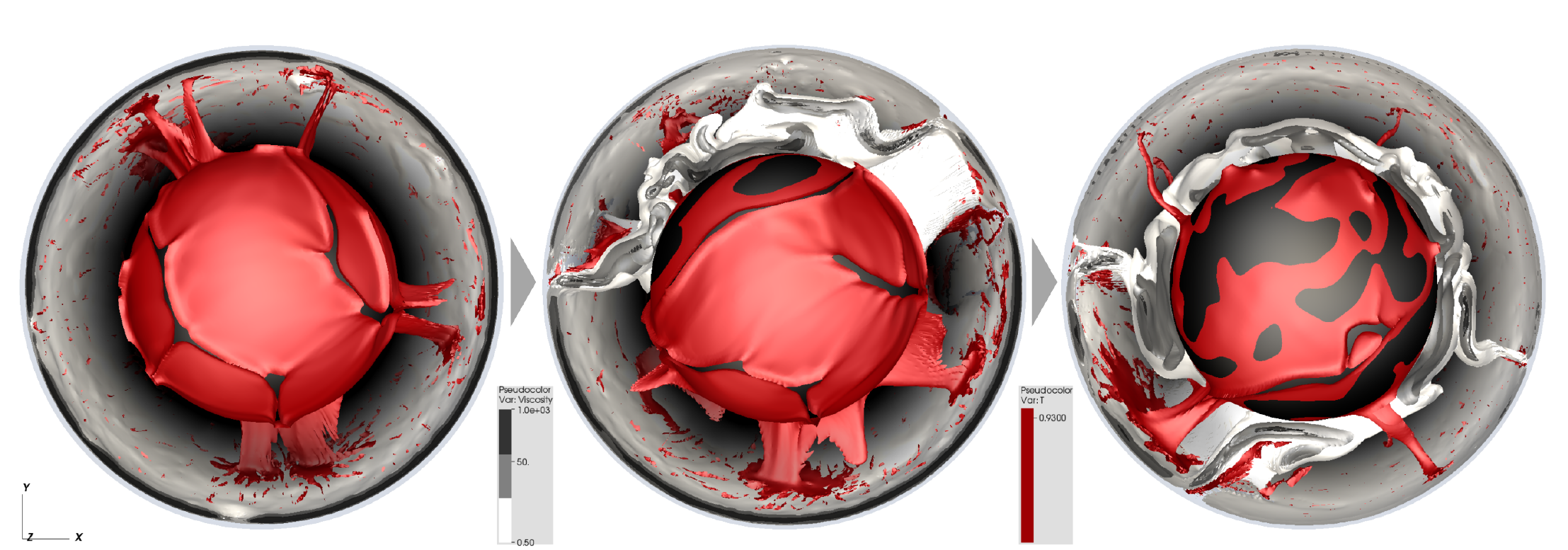|
Water Planet An Umbrella Project at the Centre for Earth Evolution and Dynamics |

|
Research Topics: Mantle Dynamics | Volcanism | Surface Deformation | Seafloor Geology | Planets |
Water and Mantle Dynamics
|
Water is present not only on the surface of the Earth, but also
within its interior. It is stored in small percentages or parts per
million in hydrous and nominally anhydrous minerals that are stable
at different pressures and temperatures. How much water is present
in the Earth’s mantle is unknown; estimates range from about half to
seven times the present-day ocean mass. The links between shallow
and deep water at the mantle scale are interesting to explore as
they affect many aspects of our dynamic planet.
The Deep Water Cycle The main carriers of water from the surface to the deep mantle are slabs (Fig. 1): when an oceanic plate sinks into the mantle at subduction zones, it carries water in the sediments, in the oceanic crust, and in the lithospheric mantle. As the slab reaches increasingly higher pressures, it heats up, and it releases part of its water at shallow depths (< 250 km) (Fig. 2). In a few thousands to millions of years, this water will find its way back to Earth surface, through volcanism (Water & Volcanism). However, in some cases, water survives this “shallow filter” and remains in the slab as it sinks to greater depths. The conditions under which water is stable inside the slab, bound in high pressure hydrous phases, are reached more easily for cold slabs. Therefore, old and fast slabs are the best candidates to bring most of the water into the mantle (Magni et al., 2014). Today, about 30% of the water that enters subductions zones at trenches is estimated to be carried deep into the mantle (van Keken et al., 2011). The fate of this water is uncertain and is currently a topic of active geoscience research. However, we do know that some of this deep water is eventually released back to the surface via ridge and hotspot volcanism. Mineral physics, geochemistry, seismic studies, tectonic reconstructions, and numerical models can all help provide a better understanding of the cycling of water between Earth’s interior and the exosphere.
Mantle Convection The Earth’s mantle is constantly convecting (Fig. 3) and the vigor of this convection is depends on many factors such as, temperature, composition, viscosity, and grain size. The presence of water in the mantle also likely has an important impact on mantle convection, since it affects rheology (e.g., Richard and Bercovici, 2009). In particular, water is thought to decrease viscosity, making the mantle weaker and allowing it to flow more easily. However, it is unlikely that water is homogeneously distributed within the mantle, instead, it is more reasonable to expect that some regions in the mantle are more ‘wet’ than others. For example, the transition zone between upper and lower mantle is thought to be a possible reservoir of water (Komabayashi et al., 2004). How this heterogeneous distribution of water affects mantle convection, both today and in the past, is still very much unknown.
References Crameri, F., & Tackley, P. J. (2016). Subduction initiation from a stagnant lid and global overturn: new insights from numerical models with a free surface. Progress in Earth and Planetary Science, 3(1), 30.Komabayashi, T., Omori, S., & Maruyama, S. (2004). Petrogenetic grid in the system MgO‐SiO2‐H2O up to 30 GPa, 1600 C: Applications to hydrous peridotite subducting into the Earth’s deep interior. Journal of Geophysical Research: Solid Earth, 109(B3). Magni, V., Bouilhol, P., & van Hunen, J. (2014). Deep water recycling through time. Geochemistry, Geophysics, Geosystems, 15(11), 4203-4216. Richard, G. C., & Bercovici, D. (2009). Water‐induced convection in the Earth's mantle transition zone. Journal of Geophysical Research: Solid Earth, 114(B1). van Keken, P. E., Hacker, B. R., Syracuse, E. M., & Abers, G. A. (2011). Subduction factory: 4. Depth‐dependent flux of H2O from subducting slabs worldwide. Journal of Geophysical Research: Solid Earth, 116(B1).
|

|
 |



